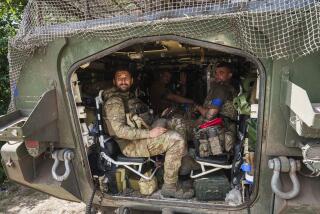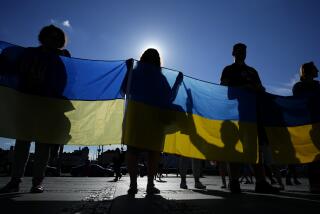Fighting eases in eastern Ukraine but economic collapse now looms
- Share via
Fighting has eased between Ukrainian government forces and pro-Russia separatists in recent days as both sides have begun to withdraw heavy weapons but the greater danger now confronting Ukrainians is collapse of their debt-strangled economy.
The national treasury’s hard currency holdings are estimated to have dwindled to less than $5.5 billion, or about as much as importers have traditionally spent every three weeks.
The hryvnia currency lost more than half its value in February, plunging to a record 34 against the U.S. dollar by Thursday. The dollar bought only eight hryvnia before the tumult of a government overthrow and separatist rebellion early last year.
Russia’s Gazprom monopoly has exerted additional pressure on the Kiev government this week by demanding payment in advance for gas to heat homes in the lingering winter months. This week Ukraine paid the Russian energy giant $15 million for a one-day supply infusion that will keep furnaces burning until Tuesday.
The Kremlin-controlled energy behemoth also began directing some of the gas bought by Kiev to the Russia-backed rebels occupying eastern Ukraine, with President Vladimir Putin chastizing Ukrainian leaders for cutting off the separatist-held areas while still claiming them as Ukrainian territory.
Ukraine’s central bank imposed new capital controls Tuesday to stem the flight of its evaporating hard currency reserves, prohibiting sales of dollars and euros on credit and severely restricting the amount each bank can sell to importers in exchange for hryvnias.
That accelerated the national currency’s decline by undermining investor confidence and prompted a one-day suspension of currency sales Wednesday. The hryvnia hit the record 34 against the U.S. dollar when trading reopened the next day.
Ukraine is due to pay its foreign creditors about $5.4 billion this year, or nearly all of the hard currency reserves it has left after a year of sharp economic contraction and the costly business of waging war against the separatists. Ukrainian President Petro Poroshenko estimated last fall that Kiev was spending $5 million a day to arm, feed and deploy troops in the campaign to recover territory and keep the country intact.
Though the government still has thousands of soldiers positioned in the separatist-held eastern regions around the cities of Donetsk and Luhansk, a marked decrease in shooting and artillery fire has been noted this week as a cease-fire that went into force on Feb. 15 belatedly takes hold. Still, three Ukrainian soldiers were killed over the previous 24 hours, Col. Andriy Lysenko, the National Security and Defense Council spokesman, told reporters in Kiev on Friday.
The Organization for Security and Cooperation in Europe, which has more than 300 monitors deployed in Ukraine to record security and cease-fire breaches, reported Friday that its personnel had witnessed the removal of heavy weapons by both sides in an atmosphere of reduced, but not wholly eliminated, artillery firing.
The European security agency also reported seeing an 85-vehicle convoy of Russian cargo and fuel trucks enter Ukrainian territory with markings portraying the delivery as “humanitarian help from the Russian Federation.” Neither the token Ukrainian customs force stationed at the separatist-controlled border nor the European monitors were allowed by separatist gunmen to inspect their contents, an OSCE spot report said.
The relative pause in hostilities has allowed the government and separatist troops to begin complying with a condition of the peace plan worked out in Minsk, Belarus, on Feb. 12, that both sides pull their tanks, mounted guns and missile batteries back from the front lines, creating a zone of separation as wide as 90 miles in places. The retreat, which began in earnest Thursday, was to have started on Feb. 16 and be completed by Sunday.
Even if the cease-fire holds -- and few expect that to be the case for more than a few days -- the hair-trigger hostility between the warring factions is likely to deter any drawdown of forces that might allow the Kiev government to spend its dwindling resources on anything but the army.
The government has been promised $40 billion in bailout loans over the next four years by the International Monetary Fund and allied Western countries. But the first $17.5 billion of the lifeline has yet to reach the treasury as the IMF waits for the Ukrainian parliament to adopt financial reforms. The measures are meant to ensure that the new loans are used wisely and not subject to the rampant corruption that has deformed the economy since Ukraine broke from the Soviet Union in 1991.
Ukraine was already heavily indebted when a pro-Europe rebellion drove out former President Viktor Yanukovich a year ago, angering Putin, who had been able to influence his Kiev ally to derail a trade and political agreement with the European Union.
Putin has sought to retain Russian influence in the former Soviet region with a rival Eurasian Economic Union, the success of which depended on Ukraine joining the bloc and intensifying already tight economic integration and joint production.
Moscow is among the creditors waiting to be paid by Kiev, most recently for the $3 billion in loans provided to Yanukovich weeks before his ouster. That gives Putin some power to scuttle an IMF-brokered debt rescheduling plan in the works for Kiev to stave off bankruptcy while the immediacy of war empties government coffers.
Follow @cjwilliamslat for the latest international news 24/7
More to Read
Sign up for Essential California
The most important California stories and recommendations in your inbox every morning.
You may occasionally receive promotional content from the Los Angeles Times.











